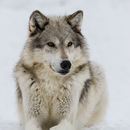Description of Canis lupus
provided by BioPedia
There are about 40 suspecies of Canis lupus (dogs and wolves) , including two domesticated subspecies (Canis lupus dingo in Australia and Canis lupus familiaris - mans best friend). Many subspecies of wolf occur throughout the Northern hemisphere. Canis lupus is assessed as Least Concern by the IUCN, as its relatively widespread range and stable population trend mean that the species, at global level, does not meet, or nearly meet, any of the criteria for the threatened categories. However, some local populations are classified as Endangered and some subspecies are endangered or extinct. The domestic dogs were derived from the gray wolf domestication about 15,000 years ago. The dog may have been the first animal to be domesticated, and has been the most widely kept working, hunting, and companion animal in human history. They quickly became widespread across world cultures. Dogs perform many roles for people, such as hunting, herding, pulling loads, protection, assisting police and military, companionship, and, more recently, aiding handicapped individuals. In some cultures, dogs are also an important source of meat. In 2001, there were estimated to be 400 million dogs in the world. Over the 15,000-year span in which the dog has been domesticated, it has diverged into a handful of landraces, groups of similar animals whose morphology and behavior have been shaped by environmental factors and functional roles.Selective breeding has produced hundreds of varied breeds, showing more behavioral and morphological variation than any other land mammal. Height measured to the withers ranges from a few inches in the Chihuahua to a few feet in the Irish Wolfhound; color varies from white through grays (usually called blue) to black, and browns from light (tan) to dark (red or chocolate) in a wide variation of patterns.

